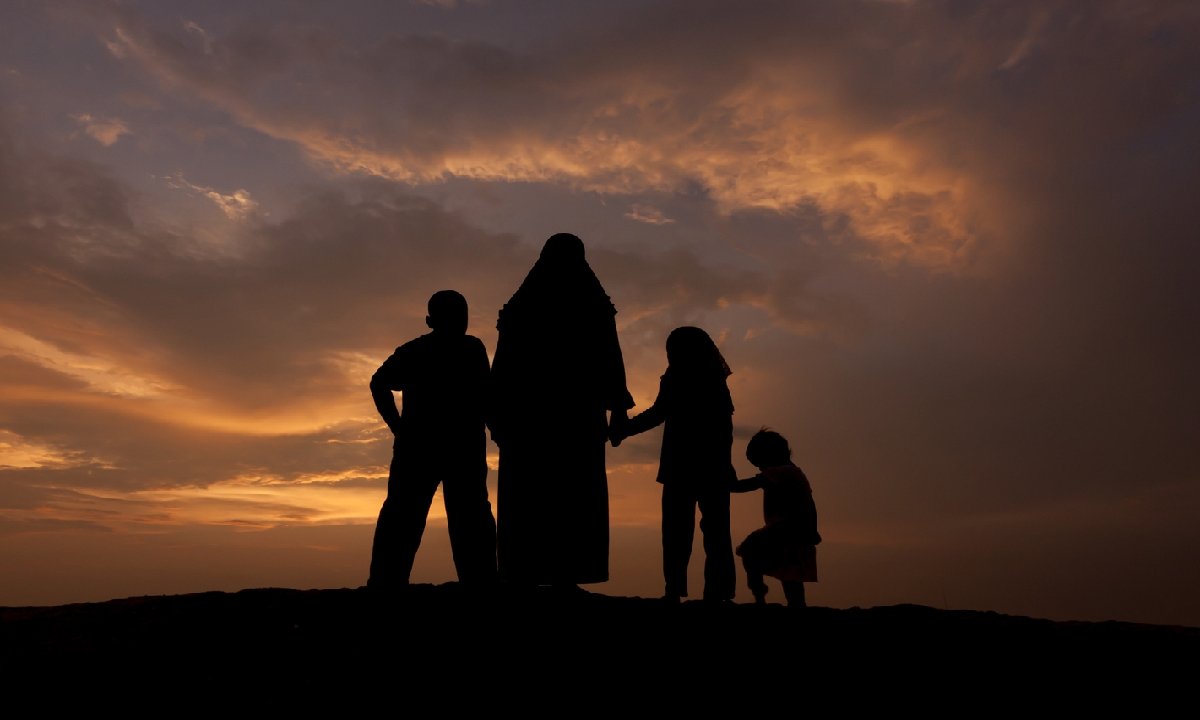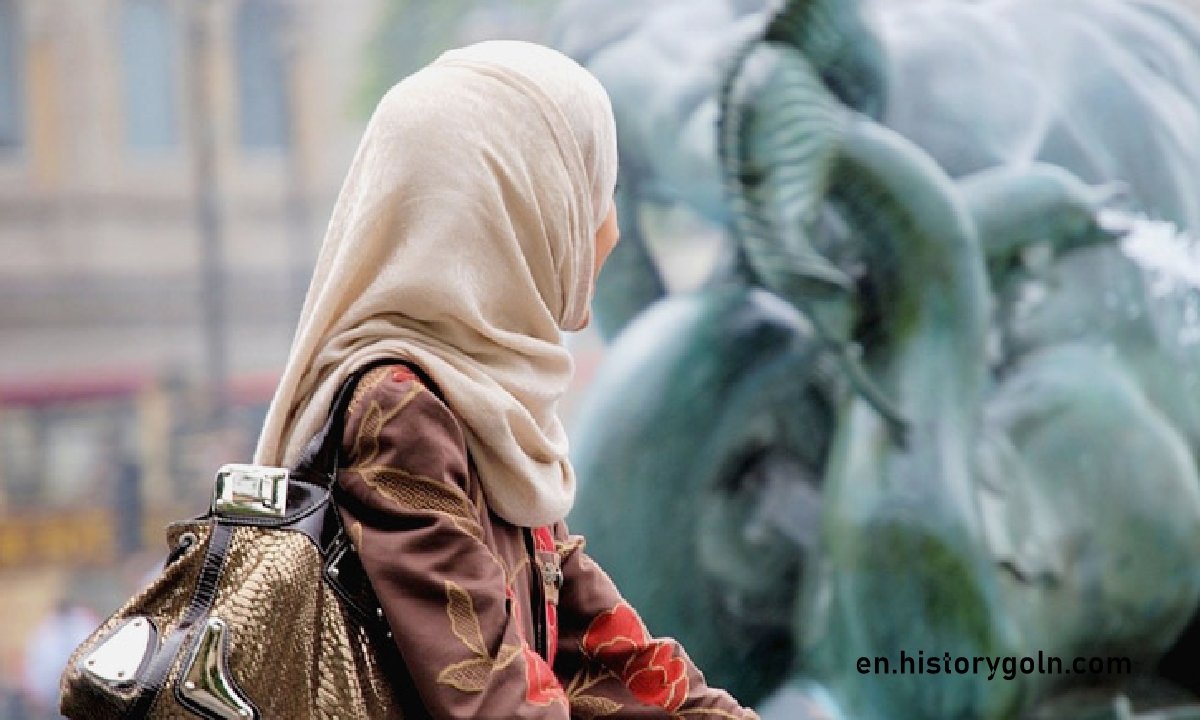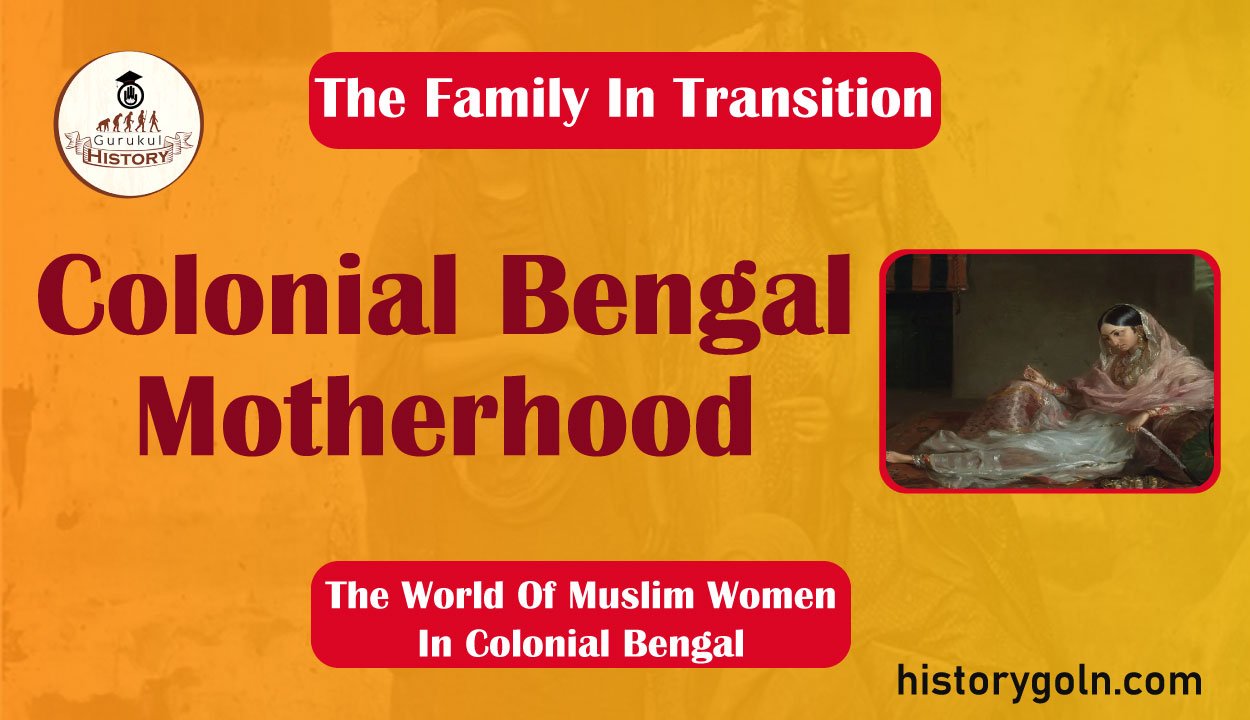Today our topic of discussion is Colonial Bengal Motherhood .
Colonial Bengal Motherhood

In Colonial Bengal motherhood was one of the most important ingredients of domestic ideology. The notion of motherhood was also the aspect which displayed more indigenous characteristics than the notion of companionship which was influenced by Victorian ideals. Motherhood was a topic over which there was much consensus among old fashioned and modern, men and women, Hindu, Muslim or Brahmo.
The principle of female energy embodied in the mother-goddesses. Durga and Kali, had always been revered in Bengal. The tide of nationalism toward the end of the late nineteenth century had co-opted the women’s movement into the anti-colonial struggle and recast ideal womanhood in terms of the powerful mother goddess as well as the acquiescent Sita- Savitri-Sati.
Hindu ‘revivalism’ of the brand preached by Bankim Chandra Chatterjee had become a common facet of the nationalist struggle, and one of the pow- erful ideological symbols or images invoked by him was that of the mother- land sanctified to represent the mother-goddess.
The symbolic power latent in a Desh-matrika humiliated by poverty, col- onization and social decadence, stalking the cremation ground, was exploi ted by Bankim Chandra Chatterjee in his aesthetic and political project.
He gave Bengal the slogan that was to be chanted by millions for many deca- des to come, Bande Mataram’. The concept of motherhood became deified and the ‘New Women’ were shown the way through which they could be meta- morphosed. True enough, they were thrust into the vanguard of the anti- colonial struggle, but at a symbolic level.
Gandhi, on the other hand, harnessed the energy let loose by Bankim’s rhetoric and gave it a powerful but pious twist. To Gandhi who eschewed violence, the mother-land personified in a blood-thirsty figure roaming the wilderness of the cremation ground at night was not palatable.
He favoured the image of Sita whom he considered the ideal woman. For him the ideal woman was she whose power stemmed from moral courage and virtue. Such were the dominant images of woman in the period under review.
The Muslim community, however, did not subscribe quite fully to this imagery. In fact, with its newly awakened (and politicized) sense of sepa- rate identity, a section of the community viewed the worship of mother- earth and motherland with some misgivings, as a concept not in keeping with the monotheistic tenets of Islam though Sita was quite acceptable.
Nor had Islam veered towards the Christian form of mother worship as exempli- fied in Mariolatory. But there were always the examples of Mother Amina. and Bibi Fatima as model mothers. Much homage was also paid to Mariam, in fact. The saints Abdul Kader Jilani and Bayzid Bostani were specially revered for their devotion to their mothers.
In a sense, the notion and role of mother in Muslim society, devoid of suggestive political and religious symbolism, more closely approximated the Victorian ideal of mother.
But ‘seasonal’ or ‘partial’ mothering practised by some Victorian mothers, as suggested by Pat Barr27, would not be found in most middle-class Bengali families. The picture of the idyllic family was made complete by the birth of a son. (In the novel Anowara, the heroine’s first born was a son and the author devotes some rapturous passages to how the infant graced the beautiful mother’s lap).
In the traditional set-up, it was understood that a woman’s greatest fulfilment lay in motherhood which ‘came to her most naturally and grace- fully. But with the onset of the new age and its didactic manuals, elaborate instructions on the fine art of mothering were set down for the young girl. The manuals were full of details on child rearing cleaning of infants, nutrition, psychological nurturing etc.
Motherhood, hitherto a silently accepted role which girls slipped into, soon became subject matter of a written discourse articulated in manuals, journals and novels. Conservative and liberal, traditionalist or modernist, pounced on any opportunity to eulogize woman-as-mother to prove how well they thought of the female sex. Motherhood was the terrain where everyone felt comfortable.
Its rediscovery became part of the reformist project which called the new woman into being. It was a major channel through which woman was salvaged from the plight of being a temptress, and placed on the lofty reformist pedestal of purity.
No less a person than Ameer Ali, writing in 1899 for the journal Nineteenth Century, reiterated the Koranic maxim “Paradise lies at the feet of one’s mother”, as a point of departure for his review of Muslim women’s role throughout history:
Cynicism has gone so far as to declare that it is woman who stands at the gate of life and poisons with her cup the existence of man. Far truer is the other saying, that ‘at the feet of the mother is Paradise’.
In the series of articles ‘Narir Katha’ mentioned above, (1926), Kasema Khatun built up a case for female education by emphasizing the social sig- nificance of the mother’s role. She declared at the outset that she would show the linkage between education and ideal motherhood:
What is woman to man? She is the mother. A short while after her installation as wife a woman craves to become a mother even if she does not wish to resign [sic] from her post as wife. In motherhood, she finds the meaning of being born a woman.
But the writer went on to say that the role now demanded new skills, viz education. It was not sufficient that a woman clean a baby’s diaper and lull it to sleep on her breast; that would not make her a mother necessarily. Her duty went far beyond this. For in her hands lay the sacred task of producing worthy sons. This, she argued, could not be achieved by the mother who only had a rudimentary education.
Not that a B.A. and M.A. were prerequisites for the task, the writer hastily added. Kasema criticized the ‘modern’ education system in general both for men and women and ple- aded for a system beneficial to both. The point being made was that, in order to be good mothers, women would have to be given the same kind and degree of education as men. Only enlightened mothers could produce sons like the All brothers and Napoleon.
The significant slant in these arguments seemed to be that while avow- ing that motherhood was the most glorious of woman’s role; education was correlated to a proper functioning of that role. The discourse on mother-hood provided a platform for advocacy of women’s education.
Srimati Subodhbala Biswas, writing for the “Mohila Mahfil section of Mohammadi in 1927, showed to a more perfect degree, how far the ideology of motherhood had been internalized by women themselves. The writer rai- sed the most burning question of the day, with regard to gender ideology:
What is the ideal of womanhood, where does she belong? Civilization could never make up its mind was woman’s place in the home, or outside it? The home, family, society-women seemed integral to all institutions and yet till one uncovered the ultimate place of women, there could not be any real progress. Subodh Bala provided an answer:

Woman is the representative of the universal Mother… The hand that rocks the cradle, rules the world [sic]. Therefore, the fulfil- ment of a woman’s life is in motherhood. By the 1930’s motherhood was fully developed as a discourse. “Matrittwa Bidya” published in Masik Mohammadi spelt out the matter in detail. Accor- ding to the essay the topic was discussed a lot but people often forgot that in this too great skill, ability and training, were required.
The quali ties of the ideal mother were enumerated –love, intelligence, selflessness, knowledge (about child care and nutrition, child psychology), and courage. Tips for the pregnant woman were also provided which included intake of fresh air, exposure to plenty of sunshine, regular exercise, nutritious diet. etc.
Most of the women who established themselves as major or minor wri- ters, devoted some time to the topic of motherhood and childcare. Rokeya Sakhawat, Akhtar Mahal, Razia Khatun and Shamsun Nahar, for instance, had pieces dealing solely with the topic. What the Muslim mohila wrote, on motherhood and childcare, resembled in many respects, the content and style of Brahmo and Hindu Bhadamohila’s writings on the subject.
Rokeya read out “Shishu Palon” (meaning ‘Child Rearing’), a very popu- lar title used by Brahmo Bhadomohila also, at a Baby Show held in the Calcutta town hall in April 1920. She addressed the issue of child care from a pragmatic angle. In a few brief words she laid down the principles of basic childcare and the necessity of educating girls to equip them for the role of motherhood.
As mentioned above, the theme of education as a prere- quisite for good motherhood ran through the works of most publicists at the time. But there was a different note in Rokeya’s article. She based her paper on infant mortality statistics; and rationalized beneficial indigenous practices pertaining to childbirth, Rokeya cited statistics for the province of Bengal and the city of Calcutta.
In the year 1891, the total mortality figure for Bengal was over 1.6 millions. Of this about one-third were below the age of 20, in Calcutta during that year alone, 6000 infants died in the atur ghar due to lack of care. Rokeya next analyzed some traditional Hindu and Muslim practices and showed their congruence with ‘modern’ scientific conclusions, Rokeya concluded her address by giving several sound and down to earth tips on baby care.
Akhtar Mahal Syeda Khatun’s short piece bearing the same title was published in Saogat in 1927. There she reiterated Rokeya’s tips on appro- priate child care. She also quoted (as had Rokeya) a rustic proverb “One does not become a mother by giving birth alone”.
Akhtar Mahal used the proverb to give substance to the new concept of motherhood and child care that was to replace age old notions. She deplored that the Hindu and Musalman mothers of Bengal had forgotten how to rear a child. The other interesting turn in the argument (provided by most other writers on the topic too) was the suggestion that lack of education as well as poverty, was a prime cause behind the declining standards of motherhood.
The changed concepts of motherhood and child care as important ele ments in the new domestic ideology, were also articulated by Razia Khatun Chaudhurani in her essay ‘Mayer Shiksha’. In the main she reiterated the arguments laid down by the others regarding the ill effects of a mother’s ignorance. Razia made a rare suggestion towards the end:
And so a little knowledge of homemaking and embroidery ought not to be the main or only characteristic of girls’ education. Sex education geared to a healthy and harmonious conjugal life is necessary. Unfortunately, Razia did not elaborate on this in her writings.
Rokeya was in effect childless as the two infants she had given birth to had died a few months after being born. She had adopted her sister’s daughter Nuri but she too died in 1931. Rokeya died the next year. Razia’s life was short, as was Akhtar Mahal’s. Both women died before attaining thirty, of ill health. Razia was a loving and dutiful mother who would at the same time often stop in the midst of a domestic chore and rush to her note book to jot down a short story or poem.
However, short biographical notes to the one-volume collected works, of the two authors hint at ill health verging on depression. Family sources were able to provide some greater details. Akhtar was married into a conservative family in the mofussil town of Comilla where her literary proclivity was frowned upon.
Razia on the the other hand was fortunate to be married into a family where her talents were appreciated. But being the wife of an idealist politician who spent much time in jail, was not quite conducive to middle class domestic bliss, having to set up home now here, now there. Sometimes Razia’s mental health gave way. As her sister recollects with poignance:
She had contracted typhoid after her marriage and had been trea- ted by the famous Dr. Bidhan Ray and Dr. Nilratan Sarkar. But she would fall ill after every child birth. Her mind would be troubled and she would say ‘what is the use of going on like this like a – mill stone round my father’s neck in Calcutta, or round my brother in-law’s in Comilla?.’ She lost her mental equilibrium 15 days after the birth of her youngest daughter.
An ayurvedic doctor Shyamdas Bachaspati was called in who administered many kinds of pastes. But Razia would throw the medicines away. And sometimes she would threaten (jokingly?) to throw the new born infant from the upper storey, holding the baby by its legs over the bannisters.36 Razia died in Calcutta, sometime after this last illness.
Whether such incidents pointed to post-partum depression, is open to conjecture. One is only tempted to say that an overall perusal of women’s life histories and narratives given one a feeling on occasion, that all was not as well in God’s universe as popular pictures of domestic bliss would have us believe. Dark shadows did exist somewhere behind the sunny fag- ade of the bhadromohila’s existence between the tightly circumscribed role of wife and mother.
Shamsunnahar Mahmud (1908-1964) belonged to the same generation as Razia and Akhter, but she lived a much longer life and an apparently happier and more active one. Unlike Akhter Mahal and Razia, she had access to formal educational institutions. She was married to a liberal lawyer who encouraged her in her career as a journalist, educationist and social worker.

Shamsunnahar’s Shishu Shiksha (Child Education) was not an article on child care, but a full-fledged book published from Calcutta in 1939. Rabind- ranath Tagore, who was experimenting with the ideal environment for the development of children at Shantiniketan, felicitated Shamsunnahar on the publication of the book: “I appreciate your work from the depth of my heart. Your writings achieve their characteristic by dint of your style, intellect and maturity.”
The book contained eight chapters with headings like: At the beginning. Harmony and discipline, Play, Fear, Truthfulness, Tenderness, Sex education and Nursery school [sic]. The chapter headings reveal the conscious cons- truction of motherhood and childhood by a bhadromohila who earned much renown as an educationist and writer. They also reveal how a segemnt of society wanted its young to develop.
See more:
